The MingQing Square
外研社初一英语下module6
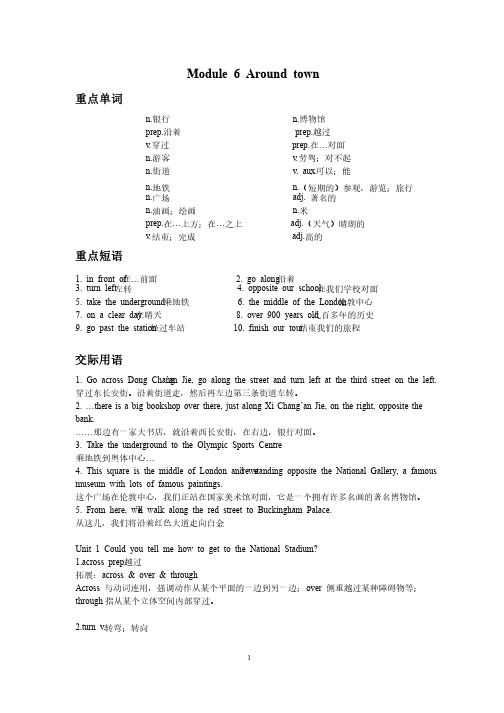
Module 6 Around town 重点单词n.银行银行 n.博物馆博物馆prep.沿着沿着 prep.越过越过v .穿过穿过 prep.在…对面对面n.游客游客 v .劳驾;对不起劳驾;对不起n.街道街道 v. aux.可以;能可以;能可以;能 n.地铁地铁 n.(短期的)参观,游览;旅行(短期的)参观,游览;旅行 n.广场广场 adj. 著名的著名的n.油画;绘画油画;绘画 n.米prep.在…上方;在…之上之上 adj.(天气)晴朗的(天气)晴朗的v .结束;完成结束;完成 adj.高的高的重点短语1. in front of 在…前面前面2. go along 沿着沿着3. turn left 左转左转左转4. opposite our school 在我们学校对面在我们学校对面5. take the underground 乘地铁乘地铁6. the middle of the London 伦敦中心伦敦中心7. on a clear day 在晴天在晴天 8. over 900 years old 九百多年的历史九百多年的历史9. go past the station 经过车站经过车站 10. finish our tour 结束我们的旅程结束我们的旅程交际用语1. Go across Dong Chang ’an Jie, go along the street and turn left at the third street on the left. 穿过东长安街。
沿着街道走,然后再左边第三条街道左转。
穿过东长安街。
沿着街道走,然后再左边第三条街道左转。
2. 2. ……there there is is is a a a big big big bookshop bookshop bookshop over over over there, there, there, just just just along along along Xi Xi Xi Chang Chang Chang’’an an Jie, Jie, Jie, on on on the the the right, right, right, opposite opposite opposite the the bank. ……那边有一家大书店,就沿着西长安街,在右边,银行对面。
圣水寺简介
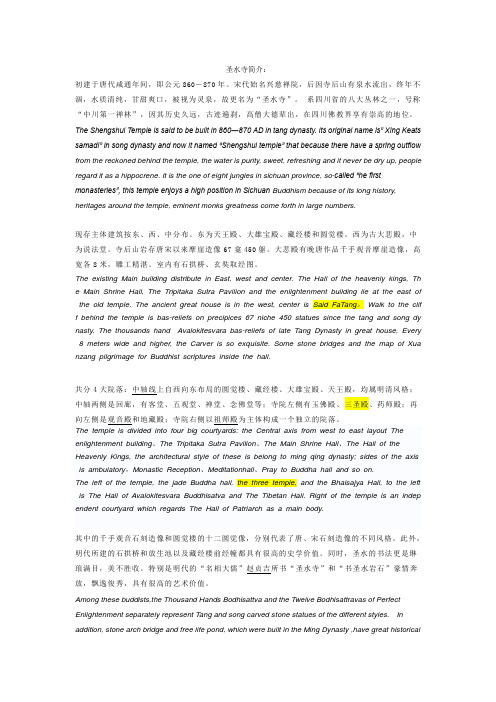
圣水寺简介:初建于唐代咸通年间,即公元860―870年。
宋代始名兴慈禅院,后因寺后山有泉水流出,终年不涸,水质清纯,甘甜爽口,被视为灵泉,故更名为“圣水寺”。
系四川省的八大丛林之一,号称“中川第一禅林”,因其历史久远,古迹遍刹,高僧大德辈出,在四川佛教界享有崇高的地位。
The Shengshui Temple is said to be built in 860―870 AD in tang dynasty. its original name is” Xing Keats samadi” in song dynasty and now it named “Shengshui temple” that because there have a spring outflow from the reckoned behind the temple, the water is purity, sweet, refreshing and itnever be dry up, people regard it as a hippocrene. It is the one of eight jungles in sichuan province,so-called “he first monasteries”, this temple enjoys a high position in Sichuan Buddhism because of its long history,heritages around the temple, eminent monks greatnesscome forth in large numbers.现存主体建筑按东、西、中分布。
东为天王殿、大雄宝殿、藏经楼和圆觉楼。
西为古大悲殿,中为说法堂。
寺后山岩存唐宋以来摩崖造像67龛450躯。
大悲殿有晚唐作品千手观音摩崖造像,高宽各8米,雕工精湛。
介绍一个京华城英语作文
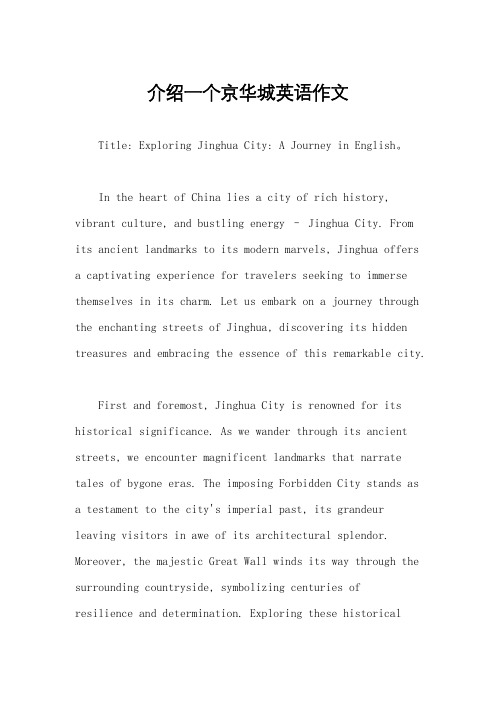
介绍一个京华城英语作文Title: Exploring Jinghua City: A Journey in English。
In the heart of China lies a city of rich history, vibrant culture, and bustling energy – Jinghua City. From its ancient landmarks to its modern marvels, Jinghua offers a captivating experience for travelers seeking to immerse themselves in its charm. Let us embark on a journey through the enchanting streets of Jinghua, discovering its hidden treasures and embracing the essence of this remarkable city.First and foremost, Jinghua City is renowned for its historical significance. As we wander through its ancient streets, we encounter magnificent landmarks that narrate tales of bygone eras. The imposing Forbidden City stands as a testament to the city's imperial past, its grandeurleaving visitors in awe of its architectural splendor. Moreover, the majestic Great Wall winds its way through the surrounding countryside, symbolizing centuries ofresilience and determination. Exploring these historicalsites offers a glimpse into China's rich heritage and the enduring spirit of its people.Beyond its historical landmarks, Jinghua City pulsates with vibrant cultural energy. From traditional tea housesto bustling markets, the city buzzes with activity,inviting visitors to immerse themselves in its dynamic atmosphere. The aroma of authentic Chinese cuisine fillsthe air as we sample delicacies ranging from savory dumplings to aromatic stir-fries. Moreover, the city's theaters and galleries showcase a diverse array of artistic expressions, from classical performances to contemporary exhibitions. By participating in these cultural experiences, we gain a deeper understanding of Jinghua's identity andthe traditions that shape its character.In addition to its rich history and culture, JinghuaCity embraces modernity with open arms. Skyscrapers adorn the skyline, their sleek designs reflecting the city's forward-thinking ethos. Moreover, Jinghua's bustlingstreets are lined with trendy boutiques and chic cafes, catering to the tastes of its cosmopolitan residents. As westroll through the city's modern districts, we witness the harmonious coexistence of tradition and innovation, a testament to Jinghua's ability to adapt and thrive in the face of change.Furthermore, Jinghua City boasts breathtaking natural landscapes that provide a welcome escape from the urban hustle and bustle. The tranquil beauty of West Lake offers a serene retreat, its tranquil waters reflecting the surrounding pagodas and gardens. Moreover, the verdant mountains that encircle the city provide ampleopportunities for outdoor adventure, from hiking to mountain biking. Amidst these natural wonders, we find solace and rejuvenation, reconnecting with the earth's beauty and serenity.In conclusion, Jinghua City captivates visitors withits blend of history, culture, and modernity. From its ancient landmarks to its vibrant streets, the city offers a multifaceted experience that leaves a lasting impression on all who wander its streets. Whether exploring itshistorical sites, indulging in its culinary delights, orsimply basking in its natural beauty, Jinghua beckons travelers to embark on a journey of discovery and enlightenment. As we bid farewell to this enchanting city, we carry with us memories of an unforgettable adventure and a newfound appreciation for the wonders of Jinghua.。
介绍泉城广场的英语作文
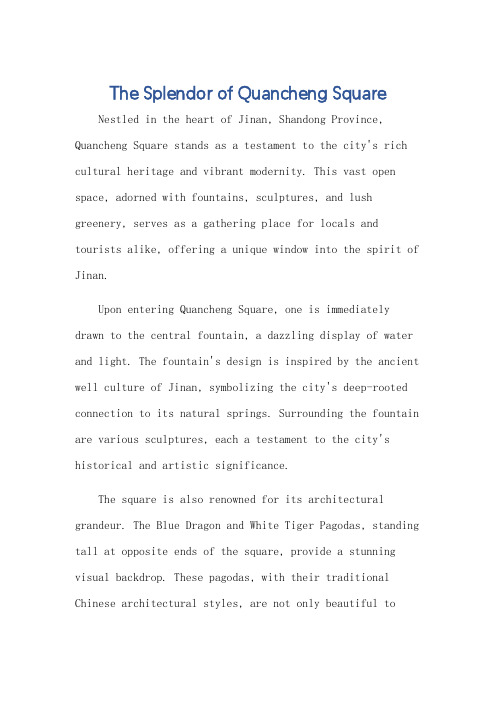
The Splendor of Quancheng SquareNestled in the heart of Jinan, Shandong Province, Quancheng Square stands as a testament to the city's rich cultural heritage and vibrant modernity. This vast open space, adorned with fountains, sculptures, and lush greenery, serves as a gathering place for locals and tourists alike, offering a unique window into the spirit of Jinan.Upon entering Quancheng Square, one is immediately drawn to the central fountain, a dazzling display of water and light. The fountain's design is inspired by the ancient well culture of Jinan, symbolizing the city's deep-rooted connection to its natural springs. Surrounding the fountain are various sculptures, each a testament to the city's historical and artistic significance.The square is also renowned for its architectural grandeur. The Blue Dragon and White Tiger Pagodas, standing tall at opposite ends of the square, provide a stunning visual backdrop. These pagodas, with their traditional Chinese architectural styles, are not only beautiful tobehold but also carry deep cultural meanings, representing the harmony of nature and civilization.In addition to its architectural wonders, Quancheng Square is also a hub of cultural activities. It hosts various festivals, concerts, and exhibitions, providing a platform for locals and visitors to immerse themselves in the city's cultural offerings. The square is often abuzz with activity, from children playing in the fountains to elderly citizens practicing tai chi under the watchful gaze of the pagodas.Moreover, Quancheng Square is a prime example of how a modern urban space can seamlessly integrate with itsnatural environment. The square is surrounded by lush gardens and parks, creating a serene and refreshing atmosphere. These green spaces provide a welcome break from the hustle and bustle of the city, allowing visitors to unwind and enjoy the beauty of nature.Finally, Quancheng Square serves as a symbol of Jinan's economic prosperity and social development. The bustling crowds, the vibrant atmosphere, and the constant flow of activities all speak to the city's vitality and dynamism.The square is not just a place to relax and unwind but also a testament to the city's progress and ambition.In conclusion, Quancheng Square is a vibrant anddiverse urban space that offers a unique glimpse into the soul of Jinan. Its combination of historical heritage, architectural grandeur, cultural activities, and natural beauty makes it a must-visit destination for anyone interested in experiencing the best of what this charming city has to offer.**泉城广场的辉煌**位于山东省济南市中心的泉城广场,是这座城市丰富文化遗产与活力的现代气息交相辉映的见证。
去三清广场的优秀英语作文
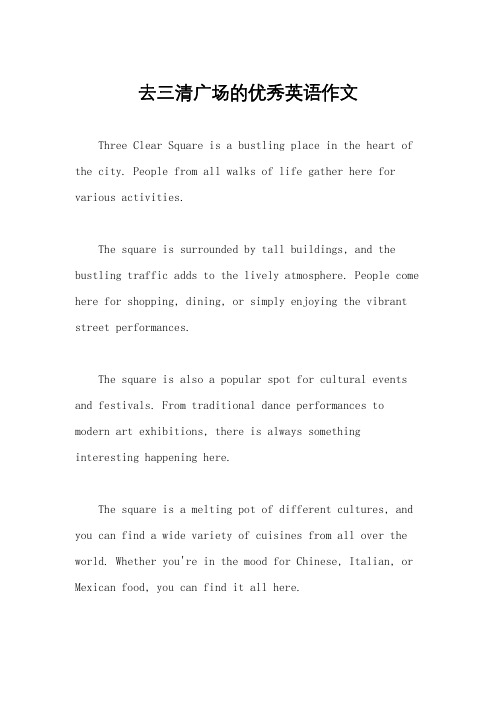
去三清广场的优秀英语作文Three Clear Square is a bustling place in the heart of the city. People from all walks of life gather here for various activities.The square is surrounded by tall buildings, and the bustling traffic adds to the lively atmosphere. People come here for shopping, dining, or simply enjoying the vibrant street performances.The square is also a popular spot for cultural events and festivals. From traditional dance performances to modern art exhibitions, there is always something interesting happening here.The square is a melting pot of different cultures, and you can find a wide variety of cuisines from all over the world. Whether you're in the mood for Chinese, Italian, or Mexican food, you can find it all here.The square is also a great place for people-watching. You can see people of all ages and backgrounds, from young children playing to elderly couples taking a leisurely stroll.In the evening, the square is lit up with colorful lights, creating a magical atmosphere. It's a great place to take a romantic evening walk or simply soak in thelively ambiance.Overall, Three Clear Square is a vibrant and dynamic place that offers something for everyone. Whether you're a local resident or a visitor, it's definitely worth a visit.。
清明节假期去泉城广场英语作文
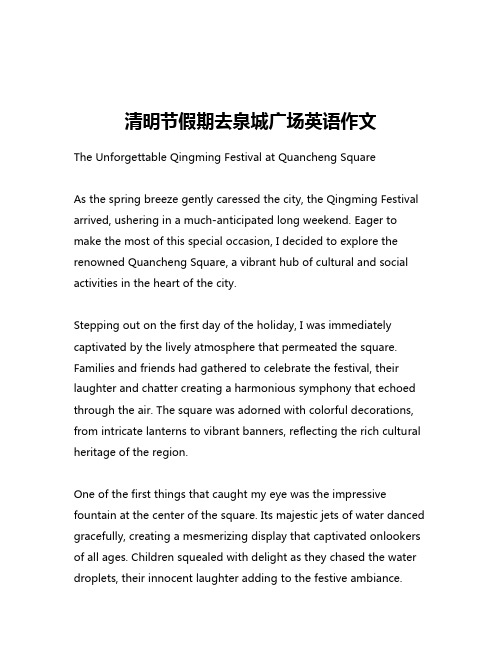
清明节假期去泉城广场英语作文The Unforgettable Qingming Festival at Quancheng SquareAs the spring breeze gently caressed the city, the Qingming Festival arrived, ushering in a much-anticipated long weekend. Eager to make the most of this special occasion, I decided to explore the renowned Quancheng Square, a vibrant hub of cultural and social activities in the heart of the city.Stepping out on the first day of the holiday, I was immediately captivated by the lively atmosphere that permeated the square. Families and friends had gathered to celebrate the festival, their laughter and chatter creating a harmonious symphony that echoed through the air. The square was adorned with colorful decorations, from intricate lanterns to vibrant banners, reflecting the rich cultural heritage of the region.One of the first things that caught my eye was the impressive fountain at the center of the square. Its majestic jets of water danced gracefully, creating a mesmerizing display that captivated onlookers of all ages. Children squealed with delight as they chased the water droplets, their innocent laughter adding to the festive ambiance.As I strolled through the square, I was struck by the diversity of activities and attractions on offer. Vendors had set up stalls selling an array of local delicacies, from steaming dumplings to fragrant street food. The aroma of these delectable treats wafted through the air, enticing passersby to indulge in the culinary delights of the region.Amidst the bustling crowds, I stumbled upon a group of musicians performing traditional Chinese instruments. Their melodic tunes filled the air, transporting me to a bygone era and evoking a sense of cultural pride. I found myself captivated by the skilled musicians, their fingers dancing across the strings with effortless grace.Nearby, a group of calligraphers had set up their stations, offering visitors the opportunity to try their hand at the ancient art form. Watching them effortlessly create intricate characters with their brushes was a mesmerizing experience, and I couldn't resist the urge to give it a try myself. As I carefully guided the brush across the paper, I felt a sense of tranquility and connection to the rich cultural heritage of the region.As the day progressed, the square continued to come alive with a diverse array of activities. Traditional Chinese opera performances drew large crowds, their captivating melodies and elaborate costumes transporting the audience to a world of timeless elegance.Acrobatic troupes showcased their gravity-defying feats, eliciting gasps of amazement from the awestruck onlookers.One of the highlights of my visit was the traditional dragon dance. Watching the sinuous, colorful dragon weave its way through the throngs of people, accompanied by the thunderous beats of drums and cymbals, was a truly mesmerizing experience. The sheer energy and coordination of the performers left me in awe, and I couldn't help but join in the enthusiastic cheers of the crowd.As the sun began to set, the square took on a new, enchanting glow. Lanterns were lit, casting a warm, amber hue across the bustling scene. Families gathered to enjoy the evening breeze and take in the breathtaking views of the city skyline. The air was filled with the laughter of children and the chatter of friends, creating a sense of community and togetherness that was truly heartwarming.As I reluctantly prepared to leave the square, I couldn't help but feel a sense of gratitude for the opportunity to experience the Qingming Festival in such a vibrant and culturally rich setting. The Quancheng Square had truly come alive, offering a glimpse into the rich tapestry of Chinese culture and traditions. It was an unforgettable experience that I knew I would carry with me for years to come.。
以导游的身份介绍北京天安门英语作文

以导游的身份介绍北京天安门英语作文全文共6篇示例,供读者参考篇1Hello, kids! My name is Jackie, and I'm going to be your tour guide today as we explore one of the most iconic landmarks in China – Tiananmen Square! Are you all excited? Let me hear a big "Woohooo!"Tiananmen Square is located right in the heart of Beijing, the capital city of China. It's a massive open space surrounded by incredible buildings and rich history. Just imagine a giant playground that can fit over 1 million people! Isn't that crazy?As we enter the square, the first thing you'll notice is the iconic Tiananmen Gate. This huge gate is made of wood and has a beautiful glazed tile roof. It looks like a giant doorway leading into a magical kingdom, doesn't it? The gate was built in the 15th century, which means it's over 600 years old! Can you believe something so old is still standing tall and proud?Right in the center of Tiananmen Square, you'll see a tall stone pillar called the Monument to the People's Heroes. This monument is dedicated to the brave men and women whofought for China's freedom and independence. It's covered with beautiful carvings and sculptures that tell the stories of these heroes. Isn't it amazing how we can honor people's courage and sacrifice through art?Now, let's talk about the Great Hall of the People. This massive building is where China's National People's Congress meets. It's like a giant meeting room for all the important leaders and decision-makers in the country. The Great Hall of the People is so big that it can fit over 10,000 people inside! Imagine having a sleepover party there – you could invite your entire school, and there would still be room for more!Across from the Great Hall of the People, you'll see the National Museum of China. This is where you can learn all about China's rich history, culture, and traditions. Inside, you'll find fascinating exhibits with ancient artifacts, artwork, and even dinosaur fossils! Who wants to be an archaeologist or a paleontologist when they grow up?But the real star of Tiananmen Square is the Forbidden City. This massive palace complex was home to 24 emperors during the Ming and Qing dynasties. Can you imagine living in a place with over 9,000 rooms? You'd never get lost, but you might need a map to find the bathroom!The Forbidden City is named that way because it wasoff-limits to ordinary people back in the day. Only the emperor, his family, and his servants were allowed inside. It was like a giant secret clubhouse for royalty!As we walk through the gates of the Forbidden City, you'll be amazed by the intricate architecture, beautiful gardens, and stunning works of art. Every detail is carefully crafted to perfection, from the colorful glazed tiles on the roofs to the intricate carvings on the walls.One of the most impressive parts of the Forbidden City is the Imperial Garden. This garden is like a secret oasis in the middle of the palace, with beautiful ponds, bridges, and pavilions. Imagine having your own personal park right in your backyard!Kids, I hope you've enjoyed our tour of Tiananmen Square and the Forbidden City. These incredible places are not just landmarks; they're living pieces of history that tell the story of China's rich culture and traditions. Whenever you visit a place like this, remember to be respectful, learn as much as you can, and appreciate the hard work and dedication of the people who built and preserved these wonders for us to enjoy.Who knows, maybe one day, you'll be the one leading tours and sharing your knowledge with others! Until then, keepexploring, keep learning, and never stop being curious about the world around you.篇2Welcome, everyone! My name is Emily and I'm going to be your tour guide today. We're going to visit one of the most famous landmarks in Beijing - Tiananmen Square and Gate! Are you excited? Let me tell you all about this incredible place.Tiananmen Square is absolutely massive - it's the largest city square in the world! Can you imagine how many people could fit here? The square itself covers an area of 44 hectares, which is about the same as 61 football fields combined. Wow!Right in the center of the square, you'll see the Monument to the People's Heroes. This granite monument was built in 1958 to commemorate revolutionary martyrs. On the pedestal, you can see inscribed the words "Eternal glory to the people's heroes!" The monument reaches up 38 meters high, nearly as tall as a12-story building.Now let's talk about the real star of the show - the amazing Tiananmen Gate! This iconic gate was first built way back in 1417 during the Ming Dynasty. Back then, it was known as the Gate ofHeavenly Peace. Can you imagine how old that makes it? Over 600 years!The gate got its current name of Tiananmen, which means "Gate of Heavenly Peace," in 1651 during the Qing Dynasty. It's an incredibly important symbol of China.Tiananmen Gate is simply massive, standing over 34 meters tall! That's about the same height as an 11-story building. The base is nearly 62 meters wide too. The whole gate, which used to be the entrance to the Imperial City, is built from gorgeous traditional Chinese architecture with intricate details and decorations.On the main gate, you can see five huge arches. The center arch was exclusively used by emperors, while other arches were for imperial wives, princes, and officials. No ordinary people were allowed to use the main gate! How cool is that?Above the center arch, take a look at those beautiful decorations. You'll see a design of a huabiao, which is an ornamental pole that represents imperial authority. And on each side are tiny cupolas with golden glaze - aren't they beautiful? Apparently there are 3,309 small images engraved on the gate. I'll let you try to count them all!Now walk through the gate and you'll find yourself in the Imperial City, where emperors used to live and rule from. This area has so much amazing history...On the north side of the square is the Gate of Heavenly Peace, which is the front gate to the incredible Forbidden City. This massive palace complex used to be the exclusive home of 24 emperors during the Ming and Qing dynasties. No ordinary people were allowed inside for nearly 500 years until it opened as a museum in 1925.The Forbidden City covers an enormous 72 hectares and has 9,999 rooms! Can you imagine getting lost in there? It was designed to be the center of the ancient Chinese universe, with cosmic diagrams and symbolism built into every detail. The whole complex used to have over 9,000 rooms for the royal family, officials, servants and guards.Some of the most famous halls and palaces inside the Forbidden City are the Hall of Supreme Harmony, the Palace of Heavenly Purity and the Gardens of Cultivated Harmony. The architecture and craftsmanship that went into building this vast complex over hundreds of years is simply breathtaking.Just behind Tiananmen Gate are two incredible traditional gardens - the Upraised Pavilion and the Pavilion of CheerfulWillows. They were built in the 18th century and were only for use by the imperial family and their guests. The gardens have beautiful rock sculptures, pagodas, pavilions and corridors surrounded by lush landscaping. I wish we could visit them!On the west side of Tiananmen Square is the Great Hall of the People, an enormous building used for legislative meetings. This modern hall opened in 1959 and has a Great Auditorium that can seat a whopping 10,000 people! The building has a huge footprint of nearly 180,000 square meters.And on the east side, you'll find the National Museum of China. This is one of the largest museums in the world, with a permanent collection of 1.3 million objects spanning all of Chinese history and culture. The museum reopened after a huge renovation in 2012 and now has nearly 200,000 square meters of exhibitions. We'd need days to see everything inside!Wow, I've talked a lot about all the incredible sights in and around Tiananmen Square! Do you have any questions about what you've learned so far?But those are just a few of the many pivotal moments that have occurred at this landmark square over the centuries. Tiananmen has been a stage for political demonstrations,national celebrations, and amazing historical events time and time again.I could go on and on about the incredible sites, architecture, history and significance of Tiananmen Square, but I'll stop here so I don't overload you with too much information! We've learned so much already.Be sure to take lots of pictures while we're visiting - Tiananmen Gate in particular makes for some unbelievable photo opportunities. What an amazing place! I'm so excited to experience this world-famous landmark with you all today.Alright, any other questions before we head out? I'll do my best to answer anything you're curious about. Otherwise, let's get going - Tiananmen Square awaits!篇3Hi there, kids! My name is Amy and I'm going to be your tour guide today to one of the most famous landmarks in China - Tiananmen Square in the heart of Beijing!Tiananmen Square is absolutely massive. It's the largest city square in the world, covering an area of about 109 acres. That's the size of nearly 100 football fields! Just try to imagine how bigthat is. The square is rectangular in shape and is surrounded on all four sides by incredible buildings and monuments from China's rich history.At the northern end of the square stands the iconic Gate of Heavenly Peace, known as Tiananmen Gate. This giant gate was built way back in 1417 during the Ming Dynasty as the entrance to the Forbidden City, where China's emperors lived with their families and ruled the country from behind those huge red walls and yellow glazed tile roofs.The gate itself is made of thick wood and has five arched doorways. In the very center is the biggest doorway, which was only used by the emperor himself. No one else was allowed to enter through that middle arch! The two arches on either side were for the emperor's family and high-ranking officials, while the two outer arches were for servants and guards.Above the gate is a unique tower structure with two stories. It's covered in green glazed tiles and has a golden roof ridge shimmering in the sun. Flying high on top is a golden sculpture of a phoenix, a mythical and sacred bird that symbolizes virtue and grace in Chinese culture. Simply breathtaking!As you step through Tiananmen Gate, you find yourself face-to-face with the magnificence of the Forbidden City straightahead. But first let me tell you about the incredible flagpole and monuments within Tiananmen Square itself.Right in the center stands a towering flagpole made of steel and concrete that reaches a height of over 200 feet! That's as tall as a 20-story building. Hanging from it is a gigantic bright red flag of China with those iconic five golden stars. Each night at sunset there is a dramatic flag-lowering ceremony that attracts huge crowds.To the east side of the square is the National Museum of China, one of the largest museums in the world with a treasure trove of artifacts and exhibits showcasing China's long history and diverse ethnic cultures. The huge modern building resembles an ancient Chinese bronzeware with its unique sloping glazed roof design.On the west side you'll find the Great Hall of the People, where the National People's Congress meets each year. It's an immense building with a semicircular shape and classic Chinese architectural features like triangular roofs and glazed yellow tiles. The Great Auditorium inside can seat a staggering 10,000 people!But the two most iconic monuments in Tiananmen Square have to be the Monument to the People's Heroes in the verycenter, and the Chairman Mao Memorial Hall on the south side. Let me tell you about them.The Monument to the People's Heroes is a massive concrete obelisk that soars up to a height of 38 meters or 125 feet. It's carved from gorgeous white granite and marble brought in from around the country. At the base of the monument are carvings of images depicting heroic characters, events and achievements of the Chinese people throughout history. The monument has steps leading up to it, so you can get an up-close look at these intricate sculptures surrounding the base.The most famous carving shows a Chinese soldier raising the national flag. This is a tribute to the heroes of World War II, when China and other Allied nations fought against the Japanese invasion. There are also sculptures showing people from different ethnic groups across China, celebrating the country's diversity and unity.Right behind the obelisk is an underground museum called the Memorial Hall of the People's Heroes. Here you can learn all about the patriotic events and people that the monument honors through artifacts, photographs, and written stories.Now let's talk about the Chairman Mao Memorial Hall on the south side of the square. This massive building is where theembalmed body of Mao Zedong, the founder of the People's Republic of China, has been preserved and put on display.The building stretches for 690 feet long and 495 feet wide - it's absolutely colossal. The exterior is built from pure white marble and has a unique pyramid shape with two sets of stairs leading up to the entrance. Out front is a huge open plaza paved in light gray granite where visitors often gather and take photos.Inside the memorial hall itself, there is a sombre atmosphere of respect as crowds slowly shuffle past the crystal glass coffin where Chairman Mao's body lies. The interior walls are decorated with impressive scenes from the revolution when Mao led the Communist Party to victory.In front of the memorial hall is a famous huge portrait of Mao that hangs on the wall above the entrance to the Forbidden City. It measures 15 meters wide and 6 meters tall - that's nearly as big as an IMAX movie screen! The portrait shows Chairman Mao smiling benevolently and was crafted from countless tiny enamel fragments by skilled artisans.Whew, that's a quick tour around the amazing sights of Tiananmen Square! We've covered the Tiananmen Gate, flagpole, museums, Great Hall of the People, the People's HeroesMonument, and Chairman Mao Memorial Hall. But there is still so much more to discover about Beijing's history and culture.Who's ready to head into the Forbidden City next? Just remember to stay with your group and listen for my tour guide flag! This place has over 9,000 rooms to explore and I don't want any of you getting lost. Let's go!篇4Hi kids! My name is Emily and I'll be your tour guide today to one of the most famous landmarks in Beijing - Tiananmen Gate! Are you all excited? Let me know by giving me a big thumbs up!Tiananmen Gate is a massive gate made of wood and stone located right in the center of Beijing. It's an incredibly important historical site in China. The name "Tiananmen" means "Gate of Heavenly Peace" in English. Pretty cool, right?This huge gate was built way back in 1417 during the Ming Dynasty. That was over 600 years ago! Can you imagine how old that is? The gate has seen so much history unfold in Beijing over the centuries.Tiananmen Gate is part of a much larger complex called the Forbidden City. This was the palace where Chinese emperorslived with their families and ran the country from. No ordinary people were allowed to enter back then, which is why it's called the "Forbidden" City. Emperors, princesses, and nobles were the only ones who could go inside!Now let me tell you about just how massive this gate is. It's 35 meters tall! That's about as tall as a 10-story building. The gate is made from incredible materials too - the base is solid marble and the beams are huge wooden pillars. On the ceiling there are gorgeous painted decorations showing dragons, clouds, and other beautiful designs.As you walk through the gate, you'll notice there are five arches. The central arch was reserved only for the emperor himself to use. No one else was allowed to walk through that middle arch back in those days. Can you imagine having your own private entrance that was off-limits to everyone else? Talk about special treatment!On the base of the gate, there are two inscribed lines written in Chinese calligraphy. They mean "Obey the ritual" on one side and "Beware the law" on the other side. These words reminded everyone who passed through to respect traditions and follow the rules.Two amazing stone lions guard the entrance of Tiananmen Gate. One has a foot on a little ball, which means it keeps peace inside. The other has its foot on a baby lion, showing it keeps threats out. These lions are over 600 years old too - just like the gate itself! Pretty cool that they're still protecting this historical site after all these centuries.Directly behind Tiananmen Gate is the massive Tiananmen Square. It's one of the biggest public squares in the whole world - large enough for over 1 million people to gather! Tiananmen Square has seen many huge events and protests throughout China's history.On the north end of the square, you'll see the Forbidden City palace complex with its bright yellow-tiled roofs. Walking through the Gate into the Forbidden City makes you feel like you're going back in time hundreds of years when emperors ruled China from here.I don't know about you kids, but I personally find Tiananmen Gate and the Forbidden City so fascinating! Just imagining all the incredible history and events that this gate has witnessed over the past six centuries gives me goosebumps. The intricate architecture and symbolic meanings behind every single detail is just awe-inspiring.What did you all think of my tour? Did you enjoy learning about the Tiananmen Gate and its incredible history? I hope getting to explore this iconic Beijing landmark has you just as excited about China's rich culture and traditions as I am! Let me know if you have any other questions.篇5Hi everyone! My name is Lily and I'm going to be your tour guide today to show you around the amazing Tiananmen Square in Beijing, China's capital city. I'm super excited because Tiananmen Square is one of the most famous places in the whole country!Before we get started, let me tell you some fun facts about this incredible square. Did you know it's the largest city square in the world? It's absolutely massive, covering an area of about 109 acres - that's almost 100 football fields! Can you imagine how many people could fit in a space that big? Millions!Tiananmen Square has a really long history too. It was built way back in 1417, over 600 years ago during the Ming Dynasty. But the square we see today was redesigned and rebuilt in 1949 after the People's Republic of China was established.At the entrance to the square, you'll see two huge gates with beautiful paintings on them. These are called the Gate of Heavenly Peace on the north side and the Qianmen Gate on the south side. They are so tall - you'll have to crane your necks to see the top! The Gate of Heavenly Peace is the main entry and gives the square its name "Tiananmen," which literally means "Gate of Heavenly Peace."As you walk through the gate into the square, the first thing you'll notice is the huge portrait of Mao Zedong hanging on the gate building. Mao Zedong was the founder and first leader of communist China. His picture looks down on the square keeping an eye on everything!In the middle of the square, there is an elevated memorial called the Monument to the People's Heroes. It was built to honor those who sacrificed their lives fighting for revolution and a new China. The huge monument has beautiful carved scenes showing people from all walks of life coming together. At the base, you can see inscriptions of the names of martyrs from different time periods. Pretty cool, huh?My favorite spot in the square is to the west side where you'll find the National Museum of China. This museum is tremendous - it's one of the largest museums in the world with over a milliontreasures inside its walls! You could spend days exploring all the ancient Chinese artifacts, artworks, fossils, and more. They even have robots and interactive exhibits that make you feel likeyou've travelled back in time. Maybe we can go inside if we have extra time at the end!But I saved the best for last - the iconic Tiananmen Gate! This famous gate stands majestically at the northern end of the square, with its iconic portrait of Mao overlooking everything. The Tiananmen Gate was where the emperors of ancient China would enter and exit the Forbidden City. Can you imagine how grand their processions must have looked?Behind the Tiananmen Gate lies the Forbidden City itself, the former imperial palace where 24 different emperors lived throughout history. Unfortunately regular tours can't go inside, but you can get a glimpse of this incredible complex of ancient buildings from outside the gate. Over 9,000 rooms make up the Forbidden City! I wish we could explore inside.Well, that's Tiananmen Square in a nutshell! As we're walking around, let me know if you have any other questions. I'll do my best to tell you all the cool stories and fascinating details about this iconic Beijing landmark. Isn't it amazing how much history iscontained in this one special square? China is so incredible! Now let's start our tour...篇6Hi everyone! My name is Lily and I'm going to be your tour guide today to show you around one of the most amazing places in my city - Tiananmen Square in Beijing!Tiananmen Square is reeeeeally big. It's the largest city square in the world! Can you believe that? It covers an area of 440,000 square meters, which is big enough to fit 90 football fields! That's a whole lot of space.Right in the center of the square, you'll see this huge picture up on the wall. That's a portrait of Chairman Mao Zedong, the founder of modern China. He was a really important leader in Chinese history. The portrait is 6 meters tall and weighs about 3 tons! That's as heavy as a couple of elephants put together. Crazy, right?As we walk through the square, you'll notice these two huge buildings on either side. Those are called the National Museum of China on the west side and the Great Hall of the People on the east side. They are part of what makes Tiananmen Square so iconic.The National Museum has TONs of cool exhibits about Chinese history, culture, and arts. You could spend days in there learning about ancient pottery, calligraphy, jade carvings, and more! My favorite is probably the dinosaur fossils. Did you know China has found some of the earliest dinosaur egg fossils in the world? So awesome!The Great Hall of the People is where the National People's Congress meets. That's kind of like China's parliament where important laws and decisions get made. Over 10,000 people can fit inside! It has this massive auditorium and impressive marble monuments outside. The architecture is stunning.But you know what the true star of Tiananmen Square is? The Tiananmen Gate itself at the north end! This massive gate was first built way back in 1417 as the entrance to the Forbidden City, which was the home of Chinese emperors for almost 500 years. How crazy is that?The Tiananmen Gate has five arches - the center one was only allowed to be used by emperors. Above the gate there is this decorative glazed tiling on the roof that looks like a mythical animal. It's a sacred symbol in Chinese culture. The whole gate is just mesmerizing with its colors and details.Every night at sunset, there is a daily flag-lowering ceremony at the gate that is really neat to watch. Soldiers from the People's Liberation Army conduct it with such precision and pageantry. The raising ceremony happens at sunrise too. I've seen it dozens of times and it never gets old!Just behind Tiananmen Gate is the incredible Forbidden City palace complex. We'll tour that on another day because there is SO much to see and do in there. It was home to two dozen emperors over the centuries and has nearly 10,000 rooms! Can you imagine having a house with 10,000 rooms? You could get lost for weeks just roaming around.Tiananmen Square has witnessed many pivotal moments in Chinese history over the centuries. Today, it's a powerful symbol of China's past, present and future. I feel so fortunate to live in Beijing and experience this amazing place regularly.On our tour today we've gotten to appreciate the grand scale of Tiananmen, learn about its iconic attractions, and understand its immense historical importance. Whether you're visiting for the first time or the hundredth time, Tiananmen Square is guaranteed to leave you in awe.What did you think? Did you enjoy our little tour? I had so much fun sharing my love for this square with you. Before we go,let me know if you have any other questions! I'm always happy to share more stories and fun facts about my favorite place. Thanks for coming along today - I'll see you next time!。
清明上河园英文作文
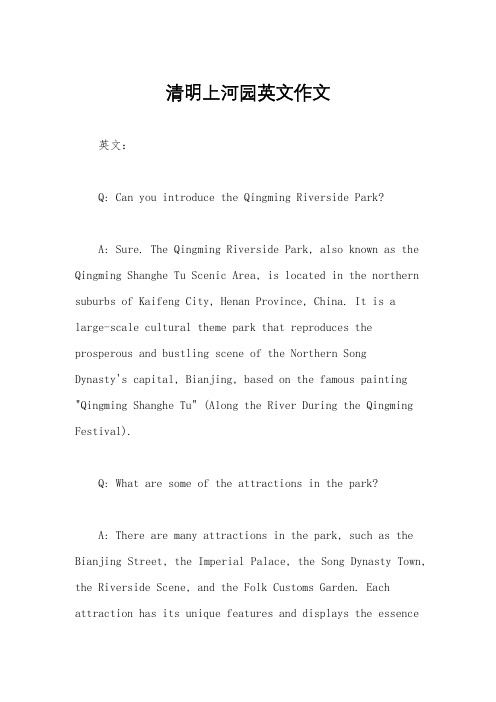
清明上河园英文作文英文:Q: Can you introduce the Qingming Riverside Park?A: Sure. The Qingming Riverside Park, also known as the Qingming Shanghe Tu Scenic Area, is located in the northern suburbs of Kaifeng City, Henan Province, China. It is alarge-scale cultural theme park that reproduces the prosperous and bustling scene of the Northern SongDynasty's capital, Bianjing, based on the famous painting "Qingming Shanghe Tu" (Along the River During the Qingming Festival).Q: What are some of the attractions in the park?A: There are many attractions in the park, such as the Bianjing Street, the Imperial Palace, the Song Dynasty Town, the Riverside Scene, and the Folk Customs Garden. Each attraction has its unique features and displays the essenceof the Northern Song Dynasty's culture.Q: What is the most popular attraction in the park?A: In my opinion, the most popular attraction in the park is the Riverside Scene. It is a large-scale landscape painting that reproduces the bustling scene of the Bian River during the Qingming Festival. It is 123 meters long and 3.3 meters high, and it vividly depicts the daily life of the people in the Northern Song Dynasty.中文:中文,你能介绍一下清明上河园吗?回答,当然。
北宋东京皇城宣德门的研究
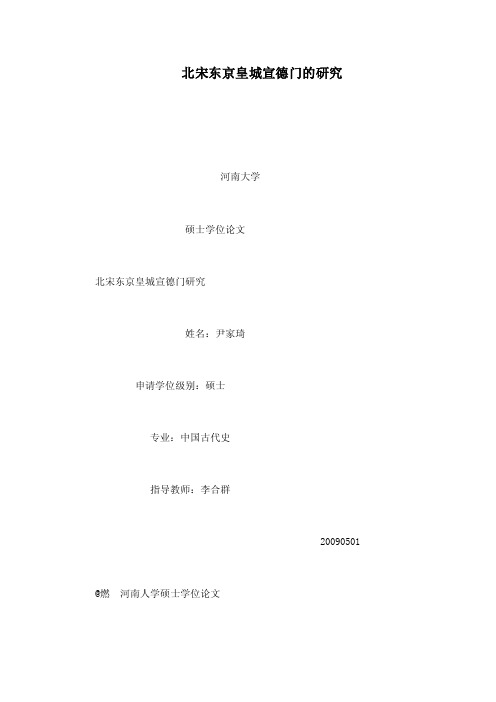
北宋东京皇城宣德门的研究河南大学硕士学位论文北宋东京皇城宣德门研究姓名:***申请学位级别:硕士专业:中国古代史指导教师:***20090501 @燃河南人学硕士学位论文中文摘要宣德门是北宋东京皇城的正南门,它来源于唐汴州城鼓角门,原来为两个城门洞,后来历经五代,直至北宋,城门洞由两个扩展为三个,最终为五个。
宣德门由门楼、左右两朵楼、东西阙楼及两侧斜廊组成,呈“凹”字形的平面布局。
它在北宋东京皇宫的建筑布局中占有重要的地位;并且对中国古代都城城门形制的演变,产生了重要的影响:具有承上启下的作用,对后来的金中都、元大都,直至明清北京城的皇宫城门形制均有影响;也是人们研究中国古代宫殿制度演变的重要资料。
另外,宣德门还是展示皇权和“君民同乐"的场所,这种功用后来影响到明清紫禁城午门。
宣德门的遗址至今仍淤埋地下,该遗址位置涉及N.-II二宋东京皇宫的位置与范围,因而有进一步探讨的必要。
本论文选取北宋东京皇城宣德门,作为研究对象。
分别从宣德门的历史沿革、结构形制、功用、和影响等方面进行分析,并对宣德门的结构形制进行复原,辨析宣德门的遗址位置。
全文共分为六章:第1章:主要介绍本课题的研究意义、国内外研究现状、结构安排及创新之处。
第2章:采用历史学式的研究方法,对宣德门在唐、五代、经北宋、金至明不同时期的名称与城门形制的沿革,进行探讨。
第3章:采用谱系学式的研究方法,对宣德门在宋画、北宋铜钟和文献资料中的具体形象与结构形制进行分析。
依据《营造法式》中的规定,用建筑学的方法,分别从城墩结构与城楼结构等方面,对五个城f-]N的宣德门进行复原研究。
本章为论文的重点内容。
第4章:主要探讨宣德门的功用。
分别从城门的启闭制度,肆赦、受献、卤簿仪仗、观灯、赐酷等活动,显示出宣德门是皇帝显示皇权和“与民同乐"的场所。
e燃北宋东京皇城宣褂J研究第5章:采用考古学式与谱系学式相结合的研究方法,对宣德门的“五门”之制及门前广场与御街的建置对辽中京、金中都、元大都、明清紫禁城的影响进行论述,使人们认识到宣德门的形制在中国古代都城城门形制演变的重要性。
介绍泉城广场周边的景点英语作文
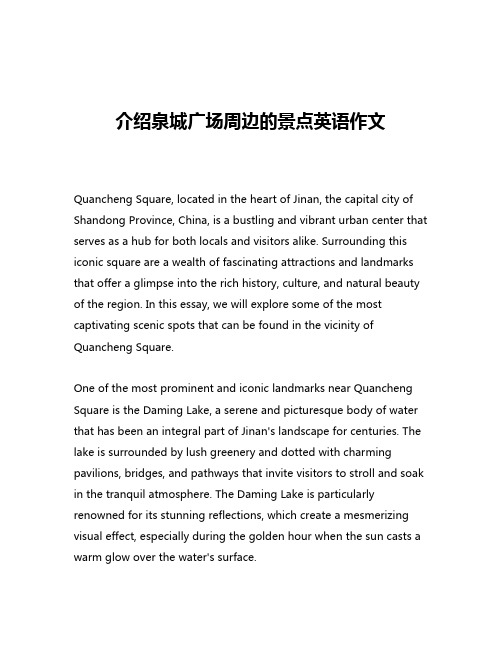
介绍泉城广场周边的景点英语作文Quancheng Square, located in the heart of Jinan, the capital city of Shandong Province, China, is a bustling and vibrant urban center that serves as a hub for both locals and visitors alike. Surrounding this iconic square are a wealth of fascinating attractions and landmarks that offer a glimpse into the rich history, culture, and natural beauty of the region. In this essay, we will explore some of the most captivating scenic spots that can be found in the vicinity of Quancheng Square.One of the most prominent and iconic landmarks near Quancheng Square is the Daming Lake, a serene and picturesque body of water that has been an integral part of Jinan's landscape for centuries. The lake is surrounded by lush greenery and dotted with charming pavilions, bridges, and pathways that invite visitors to stroll and soak in the tranquil atmosphere. The Daming Lake is particularly renowned for its stunning reflections, which create a mesmerizing visual effect, especially during the golden hour when the sun casts a warm glow over the water's surface.Another must-visit destination near Quancheng Square is the Baotu Spring, a natural spring that is considered one of the "Three Famous Springs of Jinan." The Baotu Spring is renowned for its crystal-clear waters and the unique geological formations that surround it, which include towering limestone cliffs and intricate rock formations. Visitors can explore the spring's serene gardens, admire the impressive waterfall, and learn about the spring's rich history and cultural significance through the various exhibits and displays found in the nearby pavilions.Just a short distance from Quancheng Square, one can find the Qianfo Shan, or Thousand Buddha Mountain, a picturesque hill that is home to a treasure trove of ancient Buddhist temples, grottoes, and rock carvings. The most famous of these is the Thousand Buddha Cliff, which features thousands of carved Buddhist statues and figures that date back to the Northern Wei Dynasty. Visitors can explore the various temples and shrines, admire the intricate carvings, and take in the stunning views of the surrounding landscape from the hilltop.Another notable attraction near Quancheng Square is the Furong Gu, or Hibiscus Valley, a lush and verdant oasis that is renowned for its stunning displays of vibrant hibiscus flowers. The valley is home to a variety of walking trails and scenic viewpoints that allow visitors to immerse themselves in the natural beauty of the region. Additionally,the Furong Gu is also home to several historic temples and cultural sites, including the Furong Temple, which dates back to the Tang Dynasty.One of the most unique and captivating attractions near Quancheng Square is the Zhangqiu Wetland Park, a vast and diverse wetland ecosystem that is home to a rich array of flora and fauna. Visitors can explore the park's winding boardwalks and observation decks, where they can spot a wide variety of bird species, including several rare and endangered species. The park also features a number of educational exhibits and interactive displays that provide visitors with a deeper understanding of the importance of wetland conservation.In addition to these natural wonders, the area surrounding Quancheng Square is also home to a number of historic and cultural sites that offer a fascinating glimpse into Jinan's rich past. One such site is the Shandong Provincial Museum, which houses an impressive collection of artifacts and exhibits that showcase the region's long and storied history, from ancient dynasties to modern times. Visitors can explore the museum's various galleries, which cover topics ranging from archaeology and art to traditional crafts and customs.Another cultural gem near Quancheng Square is the Jinan Museum of Art, a state-of-the-art facility that showcases the work of bothestablished and up-and-coming artists from across China and around the world. The museum's rotating exhibitions and collections cover a wide range of artistic mediums, from painting and sculpture to photography and installation art, providing visitors with a rich and diverse cultural experience.Finally, no visit to the Quancheng Square area would be complete without a visit to the Jinan Children's Park, a sprawling green space that is beloved by families and children alike. The park features a variety of playgrounds, amusement rides, and recreational facilities, as well as scenic walking paths and picnic areas that offer a peaceful respite from the bustling city. The park also hosts a variety of events and activities throughout the year, making it a popular destination for both locals and visitors.In conclusion, the area surrounding Quancheng Square in Jinan is a veritable treasure trove of scenic and cultural attractions that offer something for everyone. From the serene beauty of the Daming Lake and Baotu Spring to the rich history and cultural heritage showcased in the region's museums and historic sites, there is no shortage of captivating experiences to be had in this vibrant and dynamic corner of China. Whether you are a nature lover, a history buff, or simply someone who appreciates the beauty and diversity of the world around us, a visit to the Quancheng Square area is sure to leave a lasting impression.。
启明里景点介绍作文
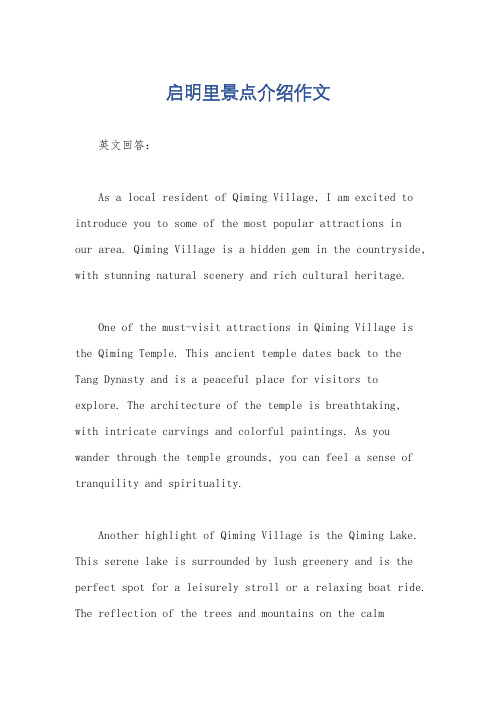
启明里景点介绍作文英文回答:As a local resident of Qiming Village, I am excited to introduce you to some of the most popular attractions inour area. Qiming Village is a hidden gem in the countryside, with stunning natural scenery and rich cultural heritage.One of the must-visit attractions in Qiming Village is the Qiming Temple. This ancient temple dates back to the Tang Dynasty and is a peaceful place for visitors to explore. The architecture of the temple is breathtaking,with intricate carvings and colorful paintings. As you wander through the temple grounds, you can feel a sense of tranquility and spirituality.Another highlight of Qiming Village is the Qiming Lake. This serene lake is surrounded by lush greenery and is the perfect spot for a leisurely stroll or a relaxing boat ride. The reflection of the trees and mountains on the calmwaters of the lake is truly mesmerizing.For those looking to immerse themselves in the local culture, a visit to the Qiming Village Market is a must. Here, you can sample delicious local delicacies, shop for handmade crafts, and interact with friendly villagers. The market is always bustling with activity, and you can experience the vibrant energy of rural life.In addition to these attractions, Qiming Village also offers various outdoor activities such as hiking, cycling, and fishing. The picturesque countryside provides the perfect backdrop for outdoor adventures, and you can truly connect with nature in this peaceful setting.Overall, Qiming Village is a hidden paradise waiting to be discovered. Whether you are a nature lover, a history buff, or a foodie, there is something for everyone to enjoy in this charming village.中文回答:作为启明村的本地居民,我很高兴向您介绍我们这个地区最受欢迎的景点。
临清名胜介绍作文英语
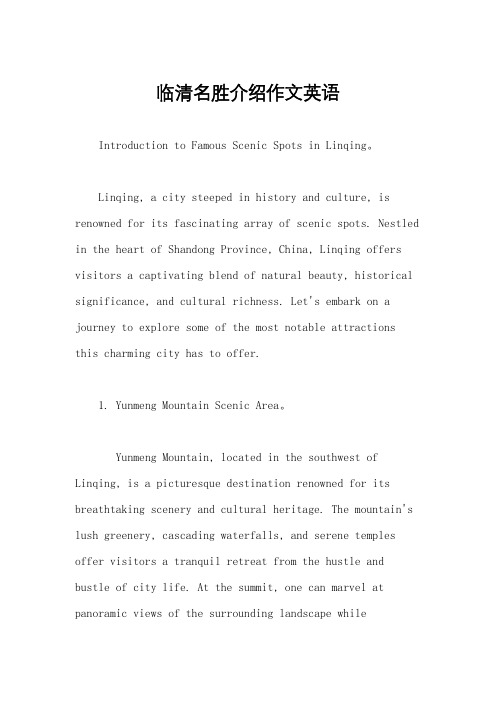
临清名胜介绍作文英语Introduction to Famous Scenic Spots in Linqing。
Linqing, a city steeped in history and culture, is renowned for its fascinating array of scenic spots. Nestled in the heart of Shandong Province, China, Linqing offers visitors a captivating blend of natural beauty, historical significance, and cultural richness. Let's embark on a journey to explore some of the most notable attractionsthis charming city has to offer.1. Yunmeng Mountain Scenic Area。
Yunmeng Mountain, located in the southwest of Linqing, is a picturesque destination renowned for its breathtaking scenery and cultural heritage. The mountain's lush greenery, cascading waterfalls, and serene temples offer visitors a tranquil retreat from the hustle and bustle of city life. At the summit, one can marvel at panoramic views of the surrounding landscape whileimmersing themselves in the spiritual ambiance of ancient Buddhist and Taoist temples.2. Yanzhou Ancient City。
关于青民街英语作文
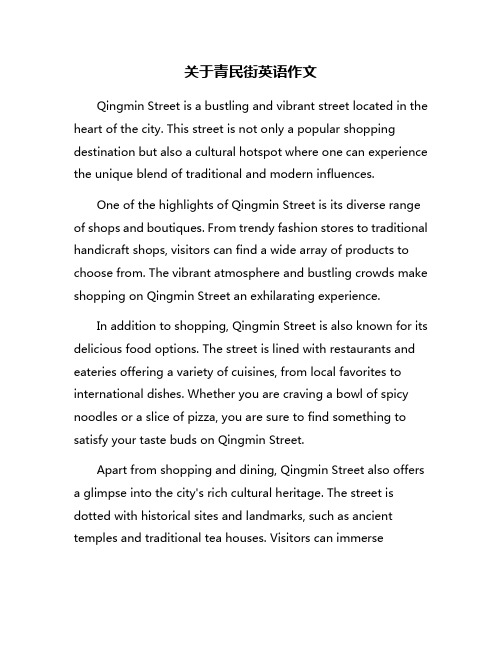
关于青民街英语作文Qingmin Street is a bustling and vibrant street located in the heart of the city. This street is not only a popular shopping destination but also a cultural hotspot where one can experience the unique blend of traditional and modern influences.One of the highlights of Qingmin Street is its diverse range of shops and boutiques. From trendy fashion stores to traditional handicraft shops, visitors can find a wide array of products to choose from. The vibrant atmosphere and bustling crowds make shopping on Qingmin Street an exhilarating experience.In addition to shopping, Qingmin Street is also known for its delicious food options. The street is lined with restaurants and eateries offering a variety of cuisines, from local favorites to international dishes. Whether you are craving a bowl of spicy noodles or a slice of pizza, you are sure to find something to satisfy your taste buds on Qingmin Street.Apart from shopping and dining, Qingmin Street also offers a glimpse into the city's rich cultural heritage. The street is dotted with historical sites and landmarks, such as ancient temples and traditional tea houses. Visitors can immersethemselves in the city's history and tradition while strolling along Qingmin Street.Overall, Qingmin Street is a must-visit destination for anyone looking to experience the vibrant energy of the city. With its bustling shops, delicious food, and rich cultural heritage, this street is a true gem in the heart of the city. So, why not plan a trip to Qingmin Street and explore all that it has to offer?。
人教(2019)必修二Unit4 History and traditions Listening

Look at the sentences below, guess the speakers’ feelings.
I had expected something different. It was like walking into history. It wasn't as big as I had expected. Some of the snacks there are amazing. I had no idea there would be so many tourists. Wow, I can't believe you didn't see the wall.
Match the words with the correct meanings. courtyard, snack, eager
• a small amount of food that is eaten between main meals or instead occteedmsoomree.thCinogmpletPeatuhlesounded sdeifnfeterennct.es to describe how_dt_his_ea_p_s_pp_oe_ina__tke_ed.rs
fIetltw.as like walking into
Leo: Guess what? I've just come back from Xi'an. It was amazing!
Li: Oh, I love Xi'an, but I haven't been there before. There are so many interesting sites. So did you see the Terra-Cotta Warriors?
介绍家乡成都的英语作文(通用5篇)
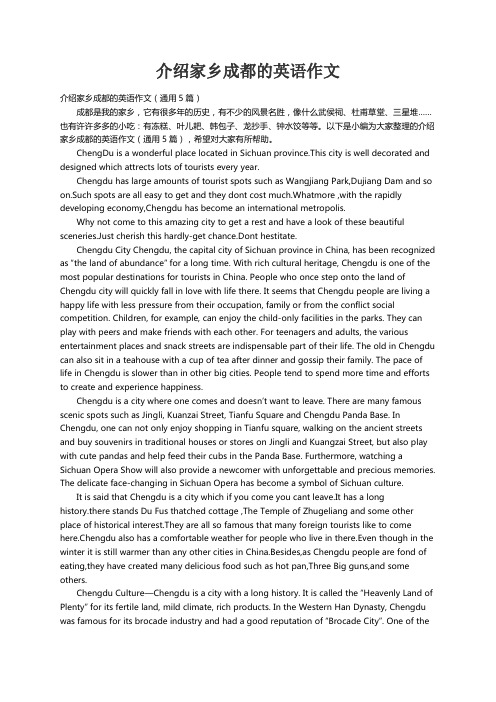
介绍家乡成都的英语作文介绍家乡成都的英语作文(通用5篇)成都是我的家乡,它有很多年的历史,有不少的风景名胜,像什么武侯祠、杜甫草堂、三星堆……也有许许多多的小吃:有冻糕、叶儿耙、韩包子、龙抄手、钟水饺等等。
以下是小编为大家整理的介绍家乡成都的英语作文(通用5篇),希望对大家有所帮助。
ChengDu is a wonderful place located in Sichuan province.This city is well decorated and designed which attrects lots of tourists every year.Chengdu has large amounts of tourist spots such as Wangjiang Park,Dujiang Dam and so on.Such spots are all easy to get and they dont cost much.Whatmore ,with the rapidly developing economy,Chengdu has become an international metropolis.Why not come to this amazing city to get a rest and have a look of these beautiful sceneries.Just cherish this hardly-get chance.Dont hestitate.Chengdu City Chengdu, the capital city of Sichuan province in China, has been recognized as “the land of abundance” for a long time. With rich cultural heritage, Chengdu is one of the most popular destinations for tourists in China. People who once step onto the land of Chengdu city will quickly fall in love with life there. It seems that Chengdu people are living a happy life with less pressure from their occupation, family or from the conflict social competition. Children, for example, can enjoy the child-only facilities in the parks. They can play with peers and make friends with each other. For teenagers and adults, the various entertainment places and snack streets are indispensable part of their life. The old in Chengdu can also sit in a teahouse with a cup of tea after dinner and gossip their family. The pace of life in Chengdu is slower than in other big cities. People tend to spend more time and efforts to create and experience happiness.Chengdu is a city where one comes and do esn’t want to leave. There are many famous scenic spots such as Jingli, Kuanzai Street, Tianfu Square and Chengdu Panda Base. In Chengdu, one can not only enjoy shopping in Tianfu square, walking on the ancient streets and buy souvenirs in traditional houses or stores on Jingli and Kuangzai Street, but also play with cute pandas and help feed their cubs in the Panda Base. Furthermore, watching a Sichuan Opera Show will also provide a newcomer with unforgettable and precious memories. The delicate face-changing in Sichuan Opera has become a symbol of Sichuan culture.It is said that Chengdu is a city which if you come you cant leave.It has a longhistory.there stands Du Fus thatched cottage ,The Temple of Zhugeliang and some other place of historical interest.They are all so famous that many foreign tourists like to come here.Chengdu also has a comfortable weather for people who live in there.Even though in the winter it is still warmer than any other cities in China.Besides,as Chengdu people are fond of eating,they have created many delicious food such as hot pan,Three Big guns,and some others.Chengdu Culture—Chengdu is a city with a long history. It is called the “Heavenly Land of Plenty” for its fertile land, mild climate, rich products. In the Western Han Dynasty, Chengdu was famous for its brocade industry and had a good reputation of “Brocade City”. One of thekings of Sichuan once planted Confederate roses on top of all the city walls, and that is why Chengdu is also called “The City of Confederate rose”. In history, Chengdu had prosperous waterways, numerous bridges, flourishing trees and flowers. It is called “the flower city”. Chengdu has so many elements that attract visitors and make them reluctant to leave. This proposal adopts the Chinese traditional paper-cut art style into the pattern design of seats,depicting beautiful scenery, delicious food and entertaining activities characteristic of Chengdu. It communicates the message that Chengdu Airlines will always offer warmhearted service to passengers.Mount Qingcheng 65km west of Chengdu, Qingchengshan Mountain (Qingchengshan) is one of the ancient cradles of Daoism. The mountain has numerous Daoist temples and sites along the paths to its peak. The area is green all year round and is known for its secluded tranquility. Jianfu Temple (Jianfu Gong) sits at the base of the mountain and is a large, well-preserved Daoist temple from the Tang Dynasty. About halfway up the mountain sits Tianshi Cave (Tianshi Dong) the temple and school of Zhang Daolin, a famous Daoist master who taught here and contributed greatly to spreading Daoism in China. The present Tianshi Cave buildings were built at the end of the Qing Dynasty. Lastly, near the peak sits Shangqing Temple, which was originally established in the Jin Dynasty, while the current temple buildings are Qing Dynasty constructions.Mt. Qingcheng is located at the Dujiangyan scenery spot of Chengdu, Sichuan province. It is a famous mountain of Taoism. Surrounded by countless peaks and densely covered by ancient trees whose branches reaching the sky, the mountain was named "Mt. Qingcheng" (Green Town in Chinese). The mountain includes two parts-the anterior Mt. Qingcheng and the posterior Mt. Qingcheng. The anterior mountain is famous for its beautiful scenery and numerous cultural and historic sites; while the posterior mountain is noted for its paradisiacal scenery, primitive and brilliant, gorgeous and mysterious.The famous scenic sites are: the Shangqing Palace, the Jianfu Palace, and the Tianshi Cave, ect. Among them, the Jianfu Palace, with extraordinary bearing, stands against thebarranca under the Zhangren Peak. It was built in Tang dynasty, and repaired for several times in the successive dynasties, now only two halls and three compounds are preserved. In the left side of the Jianfu Palace is the princess of Mingqing mansion site. Going west for 1 kilometer, visitors can find the "the natural pictures". With the rocks uprightly standing, cloud and mist thickly wreathing, visitors often fancy that they are in pictures.Two kilometers towards north comes the Tianshi Cave, the major temple of Mt. Qingcheng. According to legend, in the Eastern Han dynasty, Zhang Daolin had been here for preaching. In the Three Kings Palace, the main hall of the Tianshi Cave, the stoneinscriptionsof three kings of Tang dynasty were laid. The palace contains wood and stone tablets of past dynasties. The most famous include the Tang Xuanzongs imperial decree and Yuefeis handwriting of Zhu Geliangs Chushibiao, etc. Coming out from Tianshi Cave and passing the Fangning Bridge, visitors can reach the Zhushi Palace; unceasingly walk straight north is Chaoyang Cave; out of it, climbers could see the Shangqing Palace, which situates on a high platform. The Shangqing Palace was first built in the Jin dynasty and the extant temple was built during the reign of Tongzhi in Qing dynasty. There are stone inscriptions as "the fifthfamous mountain under the sun", " the first peak in Mt.Qingcheng" and so on in it. With its annually average temperature of 15 centigrade, Mt. Qingcheng belongs to humid subtropical monsoon climate. It is reputed as "Dong Tian Fu Di" (means wonderful mountain and happy place), "the fairyland on earth".。
明水古城的英语作文
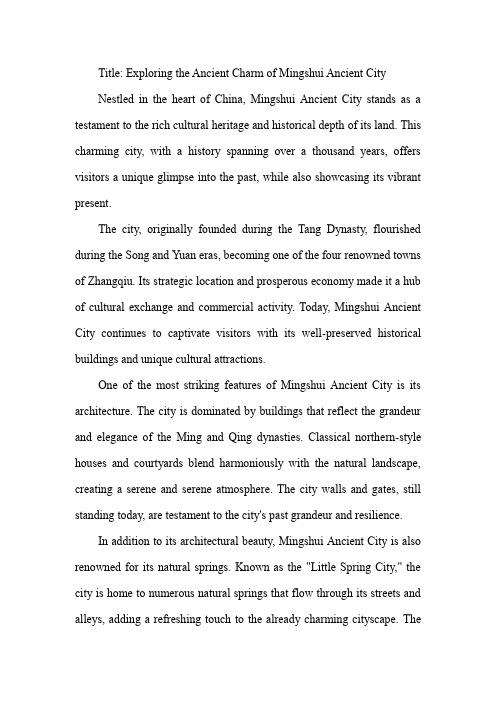
Title: Exploring the Ancient Charm of Mingshui Ancient CityNestled in the heart of China, Mingshui Ancient City stands as a testament to the rich cultural heritage and historical depth of its land. This charming city, with a history spanning over a thousand years, offers visitors a unique glimpse into the past, while also showcasing its vibrant present.The city, originally founded during the Tang Dynasty, flourished during the Song and Yuan eras, becoming one of the four renowned towns of Zhangqiu. Its strategic location and prosperous economy made it a hub of cultural exchange and commercial activity. Today, Mingshui Ancient City continues to captivate visitors with its well-preserved historical buildings and unique cultural attractions.One of the most striking features of Mingshui Ancient City is its architecture. The city is dominated by buildings that reflect the grandeur and elegance of the Ming and Qing dynasties. Classical northern-style houses and courtyards blend harmoniously with the natural landscape, creating a serene and serene atmosphere. The city walls and gates, still standing today, are testament to the city's past grandeur and resilience.In addition to its architectural beauty, Mingshui Ancient City is also renowned for its natural springs. Known as the "Little Spring City," the city is home to numerous natural springs that flow through its streets and alleys, adding a refreshing touch to the already charming cityscape. Thesprings, including the renowned Baimai Spring and Mo Spring, are a source of pride for the locals and a major attraction for visitors.Moreover, Mingshui Ancient City is a hub of cultural activities. Visitors can immerse themselves in the city's rich cultural heritage by visiting the various temples, museums, and cultural centers. Traditional performances, such as operas and folk dances, are regularly staged in the city's ancient theaters, providing visitors with a chance to experience the local culture and traditions.In conclusion, Mingshui Ancient City is a must-visit destination for anyone interested in Chinese history and culture. Its unique architecture, natural springs, and rich cultural activities offer visitors a chance to explore the ancient charm of this charming city.。
明水古城的英语作文
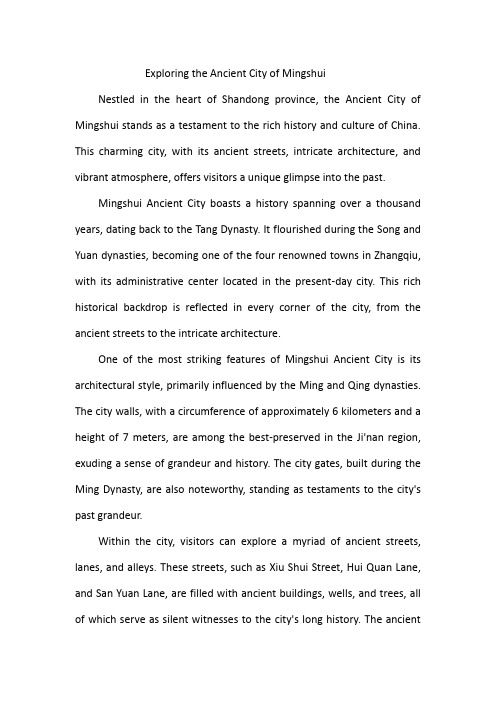
Exploring the Ancient City of MingshuiNestled in the heart of Shandong province, the Ancient City of Mingshui stands as a testament to the rich history and culture of China. This charming city, with its ancient streets, intricate architecture, and vibrant atmosphere, offers visitors a unique glimpse into the past.Mingshui Ancient City boasts a history spanning over a thousand years, dating back to the Tang Dynasty. It flourished during the Song and Yuan dynasties, becoming one of the four renowned towns in Zhangqiu, with its administrative center located in the present-day city. This rich historical backdrop is reflected in every corner of the city, from the ancient streets to the intricate architecture.One of the most striking features of Mingshui Ancient City is its architectural style, primarily influenced by the Ming and Qing dynasties. The city walls, with a circumference of approximately 6 kilometers and a height of 7 meters, are among the best-preserved in the Ji'nan region, exuding a sense of grandeur and history. The city gates, built during the Ming Dynasty, are also noteworthy, standing as testaments to the city's past grandeur.Within the city, visitors can explore a myriad of ancient streets, lanes, and alleys. These streets, such as Xiu Shui Street, Hui Quan Lane, and San Yuan Lane, are filled with ancient buildings, wells, and trees, all of which serve as silent witnesses to the city's long history. The ancientresidences, such as the Li's and Dong's residences, are particularly noteworthy, not only for their historical and cultural value but also for their exceptional architectural beauty.In addition to its historical and architectural significance, Mingshui Ancient City is also renowned for its unique cultural resources. The city is home to the famous Baimai Spring group, which includes the lively Meihua Spring and the roaring Moquan Spring. These springs, along with the city's many other natural wonders, contribute to Mingshui's reputation as a "small spring city."Moreover, Mingshui is the hometown of renowned figures such as Li Qingzhao, known as the "First Talented Woman in the World," and Meng Luochuan, the founder of the renowned Chinese brand Ruifuxiang. These individuals and their achievements are an integral part of Mingshui's rich cultural heritage.In conclusion, the Ancient City of Mingshui is a must-visit destination for anyone interested in exploring China's rich history and culture. Its ancient streets, intricate architecture, and vibrant atmosphere offer a unique and unforgettable experience.。
- 1、下载文档前请自行甄别文档内容的完整性,平台不提供额外的编辑、内容补充、找答案等附加服务。
- 2、"仅部分预览"的文档,不可在线预览部分如存在完整性等问题,可反馈申请退款(可完整预览的文档不适用该条件!)。
- 3、如文档侵犯您的权益,请联系客服反馈,我们会尽快为您处理(人工客服工作时间:9:00-18:30)。
The Mingqing SquareDarkness is falling down at a barely perceptible speed as a sure sign of autumn. The wind is no longer full of heat but bleakness. However, it doesn't matter. Hundreds of students are gathering together for some unknown reason. Within half an hour, this place alters its expression from peace and tranquility to hustle and bustle. Suddenly, as if bewitched, the crowd stop their chirp and turn to the center. Amazing music swells and heavy lights flash, adding some mystery and joy to the atmosphere. A rock music feast has just started, right here, in the magnetic Mingqing square of Anhui University. It is a place that enjoys high popularity, a square that has unique temperaments, a holy land that meets our expectations.I can scarcely remember how many times I have been standing in the square, breathing the lifeless smell of the withering grass and embracing the chilly autumn wind with dispersing mist. Y et I am not tired of enjoying this again and again, not only because of its ethereal beauty, but because of its unspeakable uniqueness.Standing on the main entrance of the square, I get a panorama of the square, which presents me with a broad vision. In the near front is an open round wide stage with a diameter of about fifteen meters and four cuboid pillars around it. Plenty of performance is showed and activities are organized here. Thanks to the elaborate design of building the stage half meter higher with six steps, audience standing farther have a fair chance to experience the liveliness and joy. People will unconsciously have a false sense of superiority when standing on the stage, but sometimes that is real. When I feel like a loser, I will come here, stand alone, glimpse at the empty bleachers about thirty meters far away, and inspire myself ,"I am somebody, you see, I am at the center of the campus!" Then motivation and confidence will flood into my heart, drive me further on the way to dream.Walking down from the steps, I know exactly how many narrow paths are there, surrounded by grass and leading to different directions. Unfortunately, the used-to-be green grasses have been heavily trampled and trodden, and now are presenting a miserable appearance, struggling painfully against infertility and begging humbling for sympathy, which always stirs up my sentiment when I pass by.Every time when my eyes search farther beyond the grass, I am impressed by the outdoor bleachers on the periphery of the square, which looks like a giant ring worn on a slender finger, leaving me innumerable imagination. A vivid picture of my footprints left on some corners of the bleachers comes to me as I close my eyes, some of which witness my toil, tears and sweater; others, joy, happiness and enthusiasm. The stands ascend with steps on the central axis till the top area where the flagpole stands. At every sunrise and sunset, standing at attention and watching the solemn flag-rising and flag-lowering ceremony have become an indispensable part of some students' life here.For me, the square alters its expressions from season to season in pursuit of beauty. Spring endows it with green and vigor; summer, red and enthusiasm; autumn, gold and maturity; winter, gray and laziness. To the attentive eyes, the expressions not only differ in the natural landscape but also in human landscape. The crisp sound of reading in the square draws the curtain of a new bright day. During the daytime, it has plenty of time to conserve strength and store up energy for the rejoices after the night falls. It is like an unwritten rule that no party will ever last later than half past nine, after when the square returns to normal.After a day's hard work, not only me, but other students would like to spend some leisure time here either sitting or standing by twos or threes. Among them are red-faced team workers arguing for some detailed plans, pleasant friends talking their heart to each other, sweet lovers flirting with their honeys, or a lonely boy meditating alone, a lovelorn girl weeping for her miserable life. When the night darkens and students leave for their dormitories, the easy and busy day for the square finally comes to an end. The night falls asleep peacefully, so does the square.One of the most peculiar scene in the square is the English Corner every Friday night. It is a special corner where I spent two years and a training task that transformed me from a shy girl to a brave speaker. For some students, attending it is as religious as going to church. No matter which school you come from and how your English proficiency is, as long as you have the desire to open your mouth and the thirst for knowledge, you will get the floor. This is an assembly for the brave who dare to challenge themselves. Heated discussion and harmonious conservation among them cheer up the atmosphere. Sparks of wisdom collide frequently. However, some unwitting passersby may mistake it for a noisy food market, when they get into the circle to seek novelty, they are involved. Sometimes, they are so devoted that they forget about the time. It doesn't matter. When dorm keepers shout angrily, "What the hell are you doing? Don't you know it's too late! ", they can just smile and reply confidently, "I am seeking wisdom," and dexterously put an end to the conservation. That is the common sequela of the English Corner.This is just a dorp in the peculiarity ocean of the Mingqing square, a place interweaving vitality with tranquility, freshness with perpetuity; a place where my imagination can go wild and my feelings can release freely. If you ever feel its unique temperament by heart, I dare say you will undoubtedly fall in love with it. Whatever, I love it.。
